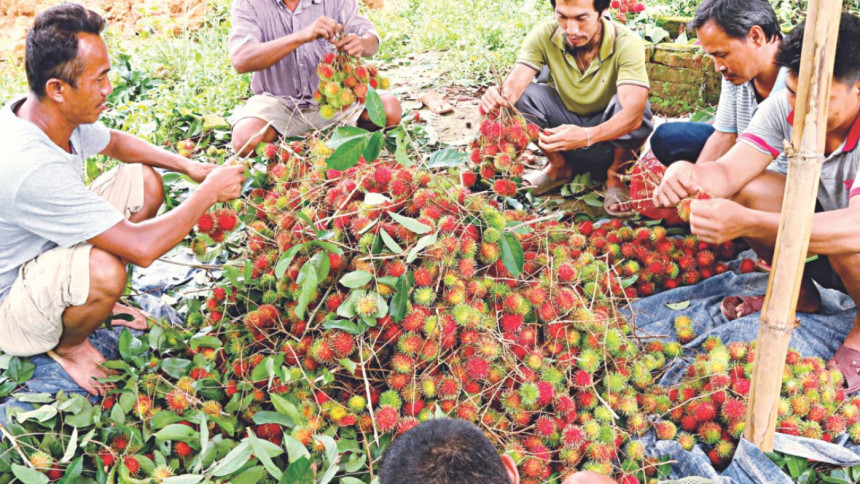Rambutan starts rocking Rangamati

Rambutan, a tropical fruit closely related to the litchi, has started making its bright colourful appearance in Rangamati.
Known as one of the more popular fruits in Southeast Asia, the rambutan is widely cultivated in many other places including Africa, the Caribbean Islands, Costa Rica, Honduras, Panama, India, the Philippines and Sri Lanka, while Thailand remains its largest producer.
Though the fruit is still not commercially cultivated in Rangamati, some rambutan trees can be seen in courtyards around houses. The fruit has begun gaining popularity amongst the locals in Rangamati.
The Rambutan flower blooms at the end of April and the fruit begins to ripen from the first week of July.
Somoyon Chakma, 40, of Rangapani village in Rangamati town, grew a rambutan tree in the courtyard of his house from seeds that his relative had flown in from Thailand.
After five long years, the tree finally bore fruits and he has already earned Tk 300,000 by selling rambutan fruits and seedlings.
“Last year, I earned Tk 200,000 from only one tree by selling the fruits and seedlings. I have been selling this year as well. Each fruit is sold for Tk 5 and seedlings for Tk 200-250. It already has a high demand in the market. People are now coming directly to my garden to buy the plants,” Somoyon said.
Inspired by Somoyon's success, many others in Rangamati have also begun planting their own rambutan trees.

One of them, Janak Chakma, 35, said he planted ten rambutan trees three years ago. “I am hoping for the fruits to come from next year,” he said.
Somoyon said, “It will be beneficial to plant the trees in hilly areas. After the end of mango, litchi and jackfruit season, rambutan is ready to be harvested and so, the demand will be high for the fruit as the weather during this time is favourable.”
Rangamati District Agriculture Department officials said they had no information yet about the growing of rambutan fruits. However, agriculturalists in the district have recently started seeing the possibility of fruit gardens in the hilly areas which would be suitable for rambutan cultivation.
Papan Kumar Chakma, deputy director of Rangamati district agriculture extension (DAE) said, “Rambutan trees are being seen in some of the houses in Rangamati. The yield is also visible. Even though it is not yet being commercially grown, the fruit has good potential to support cultivators' incomes, if proper agricultural practices are followed.”


 For all latest news, follow The Daily Star's Google News channel.
For all latest news, follow The Daily Star's Google News channel. 








Comments